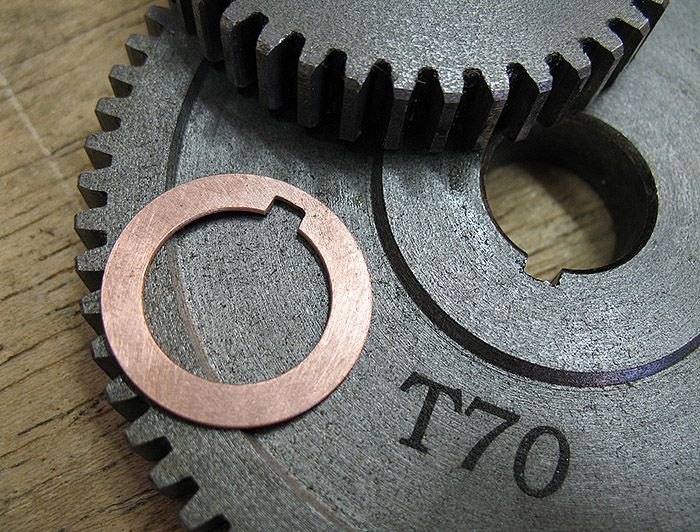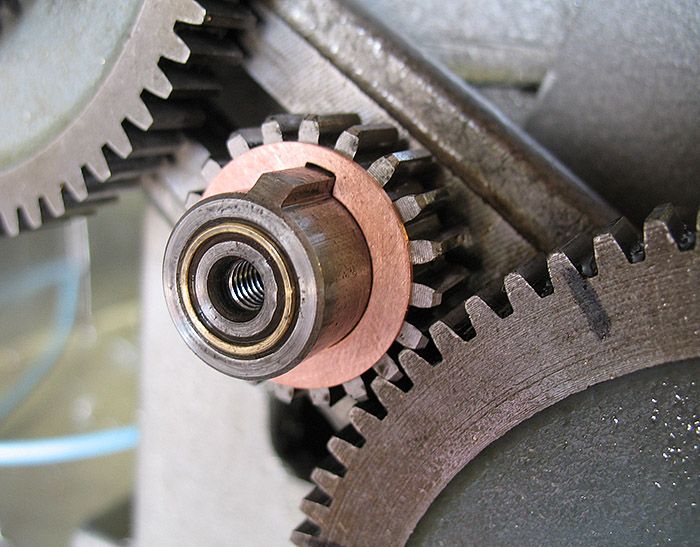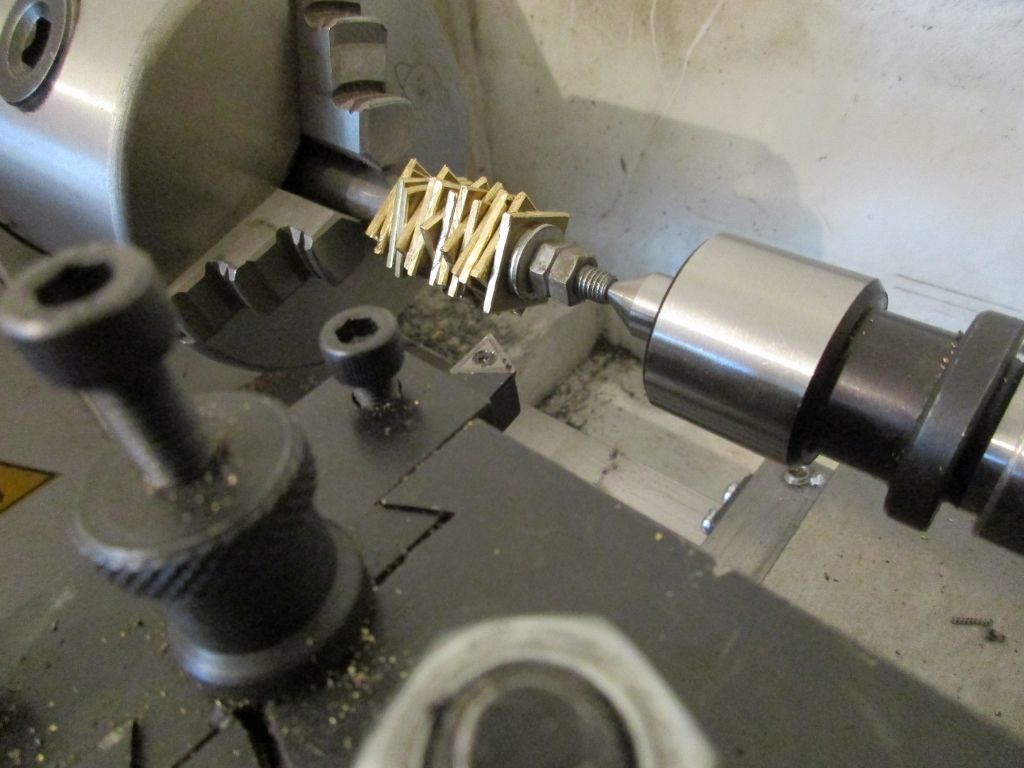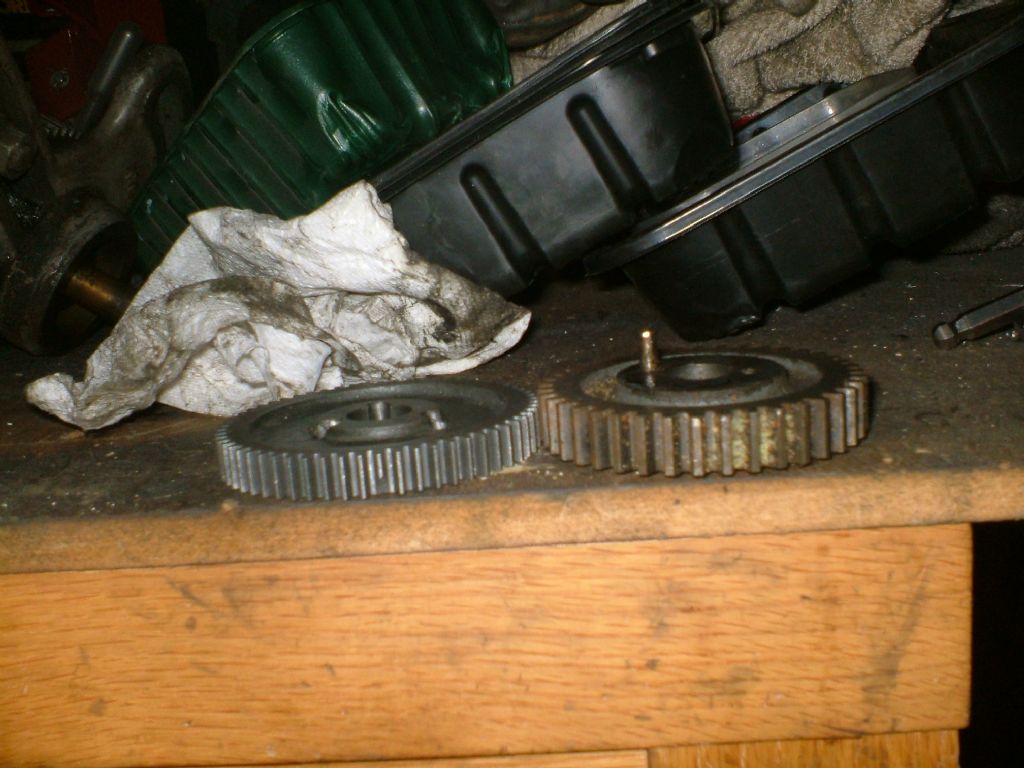Myford Gear Spacers
| Ignatz | 25/07/2021 15:46:05 |
173 forum posts 102 photos | There is a small amount of gear 'float' on the quadrant of my little Myford ML10. It functions just fine, but the sound of the gear teeth occasionally brushing against one another in operation was something I never liked. So I finally got around to fixing the problem. Using a set of feeler gauges I determined that when a pair of gears are mounted on either of the quadrant axles there is something like 0.8 - 1.0 mm of free space between them. I then found some scrap copper and machined up a pair of spacers to take up most of this space and prevent the gears from floating sideways on this axle against one another and thus (sometimes) rubbing against some of the other gears in the cluster when in operation. The spacers are nothing special; just some 0.7 mm thick copper sheet, though they could just as well be made from brass, tin, aluminum or steel since they are not subject to wear. The inner bore is 16 mm and the outer diameter 23 mm. Mounted between the gears, these spacers prevent any unwanted side-to-side gear noise. The photos below tell the rest of the story. |
| Nigel Graham 2 | 25/07/2021 15:48:20 |
| 3293 forum posts 112 photos | Good idea. I must admit I'd never considered that. Felt-tip pen mark on the wheel... Multiple thread? |
| Ignatz | 25/07/2021 15:52:45 |
173 forum posts 102 photos | Felt-tip pen mark on wheel = where I started to count to convince myself that there really were the correct number of teeth as advertised. |
| Douglas Johnston | 25/07/2021 15:59:10 |
814 forum posts 36 photos | I have experienced the same problem with my Myford Speed 10 and, like you, have just put up with it. I must get round to doing something similar for my peace of mind. I must say your handiwork looks very impressive, I am not sure mine will look quite so neat ! Doug |
| Adrian 2 | 25/07/2021 17:00:19 |
| 104 forum posts 19 photos | These spacers are fitted to the ML7R and S 7 lathes. I don't know if they are common to the ML10, could be ? Worth an ask. Beautifully made . Adrian. |
| not done it yet | 25/07/2021 19:00:42 |
| 7517 forum posts 20 photos | I’m quite confident the spacers should be 5/8” - not 16mm! Myford didn’t know much about metric. Only 15.87mm.🙂 |
| Howard Lewis | 25/07/2021 21:07:16 |
| 7227 forum posts 21 photos | I would ,not expect to find any Metric threads or dimensions on elderly British or American machines. The Myford ML1, 2, 3, 4 and 7 Series changwheels were all 5/8" bore, with Whitworth form (BSF or BSW ) fixings, to match all the other Imperial dimensions. (If you can call BA Imperial! ).. Metric threads possibly might have only crept in on the very last Super 7s, or Sigmas I suspect. We may work in Metric now, but they didn't start, in most cases, until after 1971 when the slow changeover to Metric began. Howard. |
| Mike Poole | 25/07/2021 21:24:44 |
3676 forum posts 82 photos | The spacers are supplied with a new lathe but I don’t doubt that they often get lost over the years, Myford do not appear to be listing the spacers at the moment so making your own is the best option. The originals still with my lathe are steel but I don’t think the material is important. I just measured an original spacer and it is 0.030” or 0.762mm so I think your estimate is very close and certainly will do the job. Mike Edited By Mike Poole on 25/07/2021 21:38:02 |
| ega | 25/07/2021 21:34:18 |
| 2805 forum posts 219 photos | So far as I can see, these spacers are not applicable to the gearbox model with its preset hardened steel gears but they are specified for the metric conversion set. Ignatz: were yours made with a punch and die? |
| DMB | 25/07/2021 22:30:05 |
| 1585 forum posts 1 photos | Mike Poole, I wonder when the spacers came in? Didn't even know they existed. My brand new Super7 (some years ago) didn't have them. Seems a very good idea so I'll probably add it to the roundtoit list. John |
| Ignatz | 26/07/2021 02:16:32 |
173 forum posts 102 photos | I'm guilty of using metric measure for this imperial lathe part, but in this application it doesn't matter at all. These spacers are not a moving part and their dimensions are in no way critical. The ID need only be large enough to fit over the axles and the OD small enough to never interfere with the meshing of the gear teeth. @ega - Didn't have a punch and die. I produced the spacers as follows: I clamped two oversized squares of 0.7 mm copper sheet between some small off-cuts of hardwood on my tiny mill, then drilled progressively larger diameter holes through the clamped stack - up to a 13mm drill - finally ending up with a 16 mm 4-flute end mill. Following that, I roughly nibbled away the excess copper sheet with a shear so as to convert the squares to something approximating round. Turned up a simple shouldered aluminum mandrel with a 16mm center form onto which the bored out copper sheets were mounted, secured by a hollow aluminum collar piece held in place by pressure from a live center in the tailstock. The spacer blanks thus sandwiched under pressure, I could take very light cuts with a sharp HSS bit to turn that clean exterior diameter. The slot in each spacer was cut using a jewelers frame saw with an ultra fine blade under tension (the kind that snaps if you look at it wrong) after which I used some small pattern maker's files for the final fit up. Nothing perfect here, but fit for purpose. The credit for this technique to bore and pressure turn the spacers goes to Joe Pieczynski . Check out his video on Youtube. |
| Michael Gilligan | 26/07/2021 07:42:25 |
23121 forum posts 1360 photos | Posted by Ignatz on 26/07/2021 02:16:32:
. . Since no tolerances have been stated, and the items evidently fit as you wish, it wouldn't matter if you had stated your measurements in cubits or light-years, or not at all … The snide comments were totally irrelevant. Thanks for sharing your success MichaelG. Edited By Michael Gilligan on 26/07/2021 08:07:47 |
| Howard Lewis | 26/07/2021 08:08:36 |
| 7227 forum posts 21 photos | My comment was not meant to be snide. In this case working to metric dimensions does not really matter. In other cases where closer fits are required, working to metric units could cause problems, in having to work to minute portions of a millimetre. The unit used is immaterial, just select what is easiest, and most appropriate. Don't take 39.394 inches when offered a Metre!. There may be problems finding a 6.354 mm reamer, when plenty of 1/4" ones are available, if you take my point? Howard |
| Nick Clarke 3 | 26/07/2021 08:12:19 |
1607 forum posts 69 photos | Posted by Howard Lewis on 25/07/2021 21:07:16:
We may work in Metric now, but they didn't start, in most cases, until after 1971 when the slow changeover to Metric began. I think you are out by about 150 years - see this timeline for metrification UK Metric timeline |
| Nicholas Farr | 26/07/2021 08:35:11 |
3988 forum posts 1799 photos | Hi Ignatz, very neat looking spacers. The technique for stacking and boring and subsequent outer turning is by no means a new idea, I've done it at times during my working years, albeit in a less precision way with 1 to 3mm steel, by stacking between thicker plates and all clamped up in a vice and then a couple of welds from one thick plate to the other on two opposite sides, a suitable size hole then drilled through and then mounted on a piece of threaded rod with a piece of shim if needed to keep them central and the outside turned to size. Made some small brass washers a while back in a similar way, although I drilled the holes before cutting the squares out of a piece of 1.7mm brass sheet, the holes and outer diameter not needing to be precise. Your keyway slot is also very nicely done and I've never had to do any like that, thank goodness. Never seen Joe's video before, always good to see techniques by other people, especially where a little precision is required and really thin metal is used. Regards Nick. |
| Michael Gilligan | 26/07/2021 08:35:43 |
23121 forum posts 1360 photos | Posted by Howard Lewis on 26/07/2021 08:08:36:
. […] There may be problems finding a 6.354 mm reamer, when plenty of 1/4" ones are available, if you take my point? . (a) You weren’t the first to comment, Howard (b) If I wanted a 6.354 mm reamer, I would consider 1/4” to be undersize. MichaelG. |
| Ady1 | 26/07/2021 08:57:29 |
6137 forum posts 893 photos | Drummond got around it by having a centre boss that's slightly proud and locking the wheels together with a pin |
| Howard Lewis | 26/07/2021 09:03:48 |
| 7227 forum posts 21 photos | In this instance, the Myford lathes , and many others, were manufactured to Imperial dimensions, using Whitworth form threads for almost everything,. In industry, Imperial spares and Taps and Dies were kept for repair and maintenance well into the 80s , because that what even fairly recent machine tools required. In 1971, I was sent on a course dealing with the change over to Metric. Changing a complete product over from Imperial to Metric dimensions is no mean undertaking. I've seen it happen; new composite drawings with non integer metric dimensions alongside Imperial dimensions, replacing the original Imperial dimensioned ones, for every part, before the new product made to sensible Metric dimensions is introduced, having been made to the new Metric drawings. And then there are the implications for the aftermarket and spares supply. Not unknown for components to be damaged, in the field, by trying to fit non matching components together... Count up the number of individual components in your car engine,. That means a new drawing, jigs, fixtures and tooling as well as measuring equipment needed for every single component.. Morris were not unused to Metric dimensions, having used Hotchkiss engines in the early 30s, although the rest of the car was Imperial.. IIRC the Morris Minor did not change from Whit form threads until the BMC A Series engine replaced the Morris side valve unit, in about 1954. This meant that even the wheel fixings had to be changed, with a service bulletin warning of dire consequences if the two standards were mixed.. This was one of the reasons for Unified hardware being marked to distinguish it from Whitworth form fastenings, with circles on nuts and nicks on the hexagons of bolts and setscrews, if identification was not forged into the heads. The Bristol RE and VRT buses, of the late 60s and early 70s, were a fitter's nightmare. The chassis was to Unified standards, but the Gardner engine was still Whitworth. Leyland had the same problem. The Leopard was to Unified standards, but incorporated some parts which dated from the Tiger Cub, or the PD3. The 0600 and 0680 engines were Whitworth standards, but chassis components were Unified. Sometimes it was uncertain which came from where. For instance Brake adjusters were interchangeable, but the adjuster hexagons were not!. So eventually, In service, it was possible to find a Whit hexagon on one wheel and a Unified on the other. And when the Metric standard 500 Series engine was introduced onto the Leopard chassis, you can imagine the confusion! Hence reluctance to change from one standard to another. Howard |
| noel shelley | 26/07/2021 09:55:47 |
| 2308 forum posts 33 photos | I still have whit, unified, BA, as well metric spanners ! They are used regularly ! The world has a long way to go before it will be truely metric, in fact I would go so far as to say it will never happen ! Cameras, whit, majority of hydraulics imperial, water and gas pipes in europe BSP, in fact Britains metrication board gave up ! And that's only threads, pints, tons, miles, there all still used more than most realize ! noel |
| Nicholas Farr | 26/07/2021 09:57:47 |
3988 forum posts 1799 photos | Hi, well if I were doing a similar thing as Ignatz, I would have made the hole 16mm, who would want to have to use a screwdriver as a lever to get the copper spacers off and I'm blowed if I would go to the trouble of making the hole imperial just because the pin / shaft is. Regards Nick. Edited By Nicholas Farr on 26/07/2021 10:00:02 |
Please login to post a reply.
Want the latest issue of Model Engineer or Model Engineers' Workshop? Use our magazine locator links to find your nearest stockist!
Sign up to our newsletter and get a free digital issue.
You can unsubscribe at anytime. View our privacy policy at www.mortons.co.uk/privacy
- *Oct 2023: FORUM MIGRATION TIMELINE*
05/10/2023 07:57:11 - Making ER11 collet chuck
05/10/2023 07:56:24 - What did you do today? 2023
05/10/2023 07:25:01 - Orrery
05/10/2023 06:00:41 - Wera hand-tools
05/10/2023 05:47:07 - New member
05/10/2023 04:40:11 - Problems with external pot on at1 vfd
05/10/2023 00:06:32 - Drain plug
04/10/2023 23:36:17 - digi phase converter for 10 machines.....
04/10/2023 23:13:48 - Winter Storage Of Locomotives
04/10/2023 21:02:11 - More Latest Posts...
- View All Topics
- Reeves** - Rebuilt Royal Scot by Martin Evans
by John Broughton
£300.00 - BRITANNIA 5" GAUGE James Perrier
by Jon Seabright 1
£2,500.00 - Drill Grinder - for restoration
by Nigel Graham 2
£0.00 - WARCO WM18 MILLING MACHINE
by Alex Chudley
£1,200.00 - MYFORD SUPER 7 LATHE
by Alex Chudley
£2,000.00 - More "For Sale" Ads...
- D1-3 backplate
by Michael Horley
Price Not Specified - fixed steady for a Colchester bantam mark1 800
by George Jervis
Price Not Specified - lbsc pansy
by JACK SIDEBOTHAM
Price Not Specified - Pratt Burnerd multifit chuck key.
by Tim Riome
Price Not Specified - BANDSAW BLADE WELDER
by HUGH
Price Not Specified - More "Wanted" Ads...
Do you want to contact the Model Engineer and Model Engineers' Workshop team?
You can contact us by phone, mail or email about the magazines including becoming a contributor, submitting reader's letters or making queries about articles. You can also get in touch about this website, advertising or other general issues.
Click THIS LINK for full contact details.
For subscription issues please see THIS LINK.
Model Engineer Magazine
- Percival Marshall
- M.E. History
- LittleLEC
- M.E. Clock
ME Workshop
- An Adcock
- & Shipley
- Horizontal
- Mill
Subscribe Now
- Great savings
- Delivered to your door
Pre-order your copy!
- Delivered to your doorstep!
- Free UK delivery!















 Register
Register Log-in
Log-in


